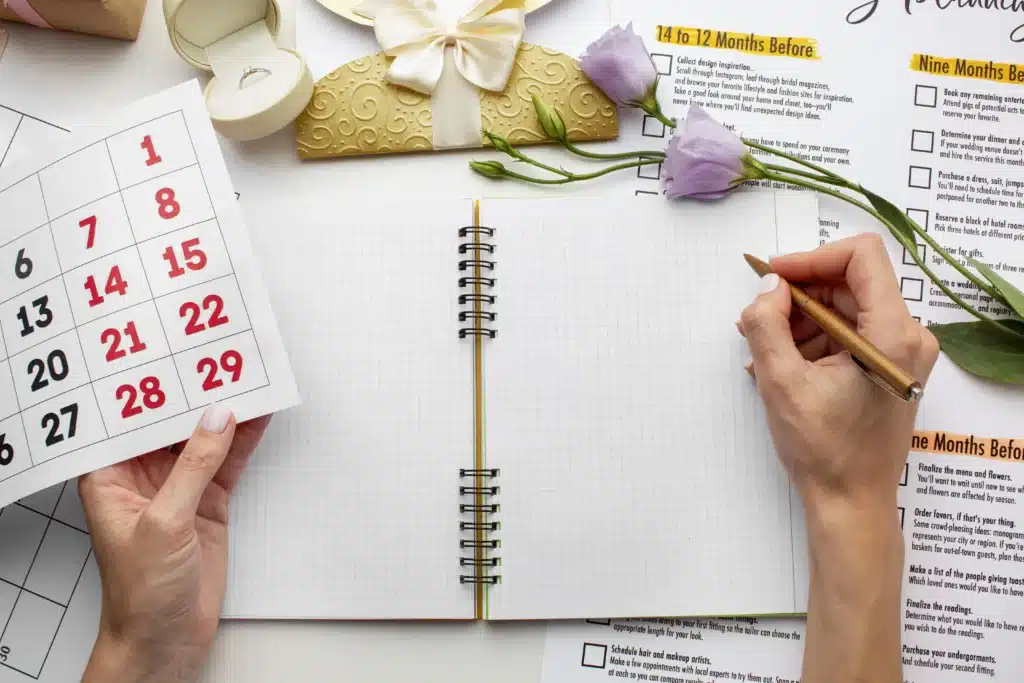As technology has advanced, many people have started using digital planners to manage their schedules and to-do lists. These planners have found their place in offices, schools, and personal spaces, and users are spoiled for choice. Though there are several options available on the market, the debate of digital vs. paper planners still manages to be a hot topic.
It is a well-known fact that planning is crucial when it comes to managing daily tasks. Whether you are a student, a teacher, a businessman, an entrepreneur, or a blogger, a handy planner helps you tackle each of your tasks productively. It is a focal point for all your information.

While digital planners are all the rage on the market, paper planners are still useful and preferred by many for a variety of reasons. Whether you want to go for a digital planner or a paper planner, the choice is entirely yours.
The Digital Planner Vs Paper Planner winner ultimately depends on your preferences, individuality, and needs. However, if you are still deciding which planner is better suited for you, this article elucidates the features of both and helps you choose one in the end.
Digital vs. paper planner: The deciding factors
In the process of choosing an efficient planner, there are some key qualities you should look for. Features that should not be compromised at any cost in the battle of paper vs. digital planners are:
- Layout: A planner should assist you in efficiently arranging your goals, appointments, and chores. So, it must have distinct sections for weekly, monthly, and daily planning.
- Customization: A planner needs to be adaptable enough to meet your unique requirements. This includes sections that you may customize, pages that you can add or remove, and the flexibility to select the layout that best suits your needs.
- Portability: You should be able to carry a planner with you everywhere you go. This means that it should be big enough to write comfortably but still small enough to fit in a bag or pocketbook.
- Ease of Use: A smart planner should be simple to use. This includes an easy-to-read font, a clear structure, and easy navigation.
How does a Digital Planner Vs Paper Planner differ?
A paper daily planner is a printed tool with dated entries and an annual calendar format that you can use to manually record your appointments and tasks for the day, week, or month.
These planners come in an endless variety of designs and sizes, and they can have extra room for lists, objectives, routines, and events.
On the other hand, a digital planner is a downloaded program or online platform that enables you to electronically schedule all of your work and responsibilities in a calendar for the coming days, weeks, and months.
Digital planners are often cross-platform, including several automatic capabilities, and may be remotely shared with others.
Both of these come with their advantages and disadvantages. To have a better understanding, let us look at the individual pros and cons of a digital planner vs. a paper planner.
Pros of a Digital Planner
Seamless synchronisation:
A lot of digital planners allow you to sync your schedule across several devices. You can synchronize them between your office and home devices and access them from anywhere.
These planners also allow syncing between Google Calendar and Outlook Calendar—the added advantage of a digital planner vs. a paper planner.
Accessibility:
Digital planners can be used from any location with an internet connection. You can quickly access your planner from your computer, tablet, or smartphone,
whether you’re at work, home, or on the go. This reduces the stress of carrying a device or a book wherever you are going.
Personalisation:
When it comes to personalization, digital planners have more choices than paper ones. You may customize your layout, colors, and themes by selecting from a range of options.
Boss Personal Planners’ customizable digital planner can be tailor-made. It comes with hundreds of inserts and extension packs to meet your daily planning needs.
Reminders and data backup:
Digital planners give you reminders and notifications about upcoming events, deadlines, and appointments. This can help you stay on schedule and avoid missing deadlines.
Also, digital planners sync all the data with the cloud or Google Drive as a backup. So even if you lose your device or accidentally delete something, you will find it again.
Easy update:
There is no limit on how many times you can update or make changes to your plan in a digital planner. If there is a change in the meeting schedule, simply erase the previous entry or write a new one.
If there are additional notes or plans to be added to the schedule, add extra pages in between the existing ones. Stay cool and stress-free while using a digital planner vs. a paper planner, as even if you make a hundred mistakes, you can edit them all.
Easy to share:
It’s effortless to share your calendar with others when you use a digital planner. This comes in handy when you have arrangements to set up with friends, family, or coworkers.
Cons of a Digital Planner
Battery Life:
Because digital planners run on batteries, you’ll need to keep your gadgets charged to use your planner. If your battery dies, you will be unable to access your routine until it is recharged.
Distractions:
Digital planners may cause you to become sidetracked, particularly if you get alerts for social media, emails, and texts. Setting limits and minimizing distractions are crucial when using a digital planner.
Learning time:
Using a digital planner may require some getting used to if you’re less familiar with electronic devices and technology. Getting acquainted with the features and interface could take some time.
Technical errors:
If you use various operating systems, you could be juggling multiple systems at once. If you can’t keep them in sync, things can easily slide through the cracks.
Pros of using a paper planner
Requires no power source.
A paper planner vs. a digital planner requires no power source to operate. You do not have to worry whether your computer, iPad, or smartphone is charged to access your daily planner.
Tangible experience
There is an eccentric experience with using pens and paper. The experience of jotting down something using your favorite stationery brings a sense of satisfaction. It also brings out creativity and helps you remember things better.
Offline mode of operation:
A paper planner does not require a data connection to be used. It runs offline, and there are no extra charges for internet for you to pay.
Easy use:
Using a paper planar does not require you to be familiar with new technologies. It allows you to easily make last-minute modifications in case something comes up or needs to be rescheduled. You just need to take out your pen and start writing! On the other hand, it can be difficult to add new assignments or events to digital calendars.
Personalization:
You can make your paper planner special to you by adding personal touches. It is fun to personalize a paper planner by decorating the cover, pages, and other elements.
In addition to being a creative way to express yourself, this aids in your memory of the assignments on each vibrant page.
Fewer Distractions:
Compared to digital planners, paper planners may be less distracting because they don’t have pop-ups or notifications. This can help you remain focused and productive.
Cons of using a paper planner
Difficult portability
Using a paper planner on a daily basis can make the book cumbersome to transport. The more pages you add, the more difficult it is to fit them into your bag or briefcase. Also, if there are pages of different sizes and shapes or sticky notes, some of them may be lost or torn while handling.
No reminders
Sometimes we get so soaked up in work that we forget about important meetings and classes. A digital planner helps you with that by giving timely reminders. But a paper planner cannot do this for you. So if you forget any meet-ups or tasks, you have to plan them for later.
No Synchronisation:
If you use separate devices for business and personal use, you will need to manually make changes to your schedule because paper planners do not sync across devices.
Difficult to share:
We know how easily we can share information online these days. Just a click, and all the plans are sent to your colleagues and friends. However, a paper planner is difficult to share. Unless you manually hand the book to your peers, they are unable to access any information.
Digital planner vs. paper planner: which one consumes less time?
The ultimate goal for planning, whether it is on paper or on a device, is to manage your time more efficiently. So you need to consider which one is better at time management.
Let us say you manually write out your calendar on paper every day for roughly thirty minutes, including planning, putting everything out, and handling any schedule adjustments. Even though it may not seem like much, by Friday, that builds up to 2.5 hours.
However, by using a digital planner instead of a paper one, you can streamline your planning procedure and boost your weekly output because it will create a schedule that automatically fits all of your priorities.
Final words
Weighing out the advantages and disadvantages of both of these planners is critical before making a choice. We have successfully pointed out everything in this article that can help you in the process. Nonetheless, the choice is yours, and you get to decide what works more conveniently for you.

Hey there! I’m Megan Taylor, an entrepreneur with a fire in my belly for using technology to change the game. I’m passionate about launching ventures that make a real impact, and I’m always on the lookout for the next big thing in digital innovation.
What gets me going?
- Building Businesses: I love the thrill of taking an idea and turning it into a reality. From crafting strategies to watching a business flourish, the journey is what excites me.
- Tech Transformation: Technology is constantly evolving, and I find it fascinating to explore how it can revolutionize different aspects of our lives.
- Smart Solutions: Give me a problem, and I’ll find a tech-powered solution! I’m drawn to gadgets and apps that can simplify our daily routines and empower us to do more.
Why You’re Here:
If you’re looking for insights on the latest tech trends, reviews of ingenious gadgets, or tips on using apps to streamline your life, you’ve come to the right place. I love to share my knowledge and experiences, and I’m always eager to connect with fellow tech enthusiasts.
Let’s Explore Together!
Whether you’re a seasoned entrepreneur or just starting your digital journey, I invite you to join me on this adventure. We can discuss the latest tech breakthroughs, share tips and tricks, and explore how technology can help us build a better future.
Feel free to browse my articles, leave comments, and connect with me on social media. Here’s to pushing boundaries, embracing innovation, and using technology to make a positive impact!




